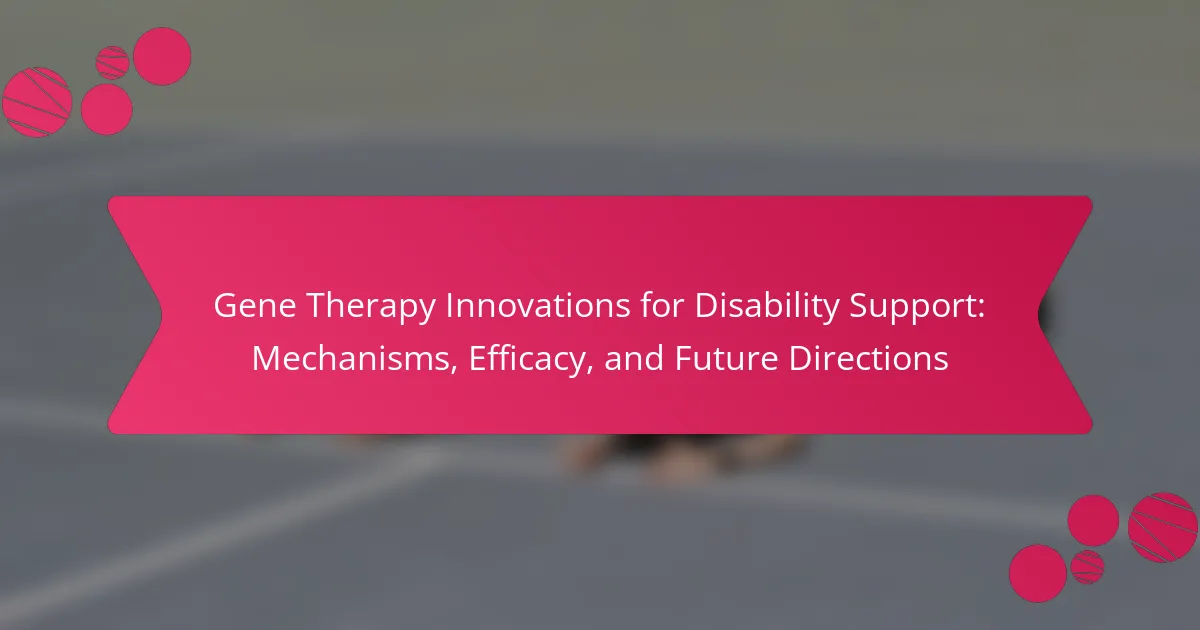Gene therapy innovations are transforming disability support by addressing the genetic foundations of various conditions. This article explores mechanisms like gene replacement and editing, assesses their efficacy in clinical trials, and examines future directions such as CRISPR advancements and new delivery systems. Ethical considerations and accessibility challenges are also discussed to provide a comprehensive overview of this evolving field.
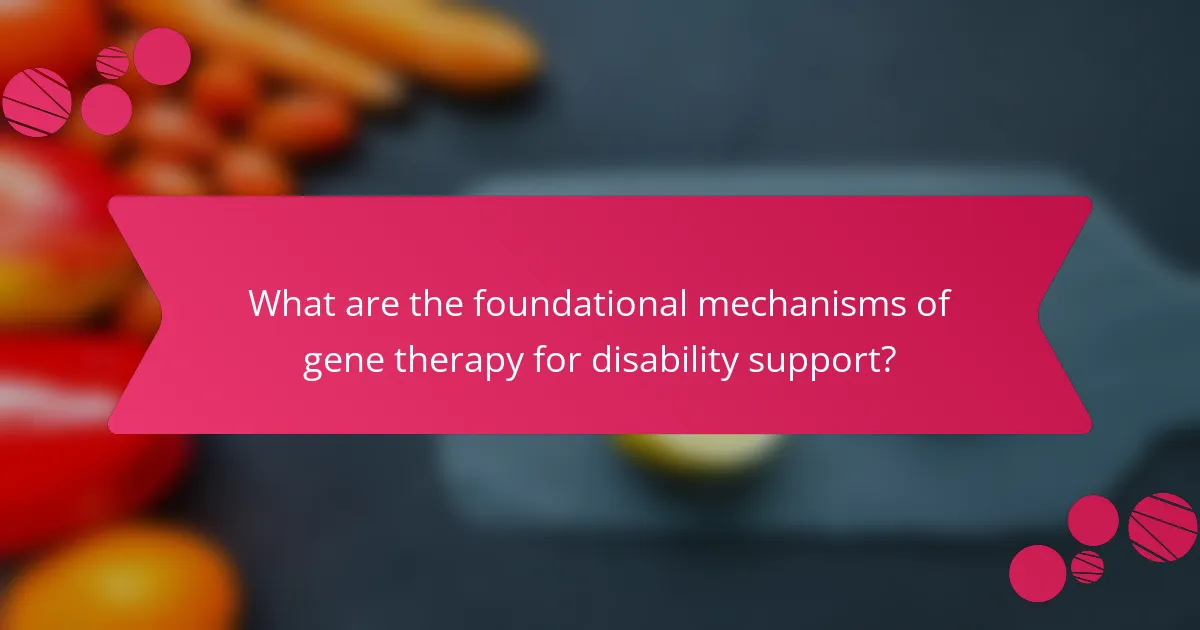
What are the foundational mechanisms of gene therapy for disability support?
Gene therapy for disability support operates through mechanisms such as gene replacement, gene editing, and gene silencing. These approaches aim to correct or compensate for defective genes responsible for disabilities. Gene replacement introduces healthy genes to replace malfunctioning ones, while gene editing modifies existing genes to restore normal function. Gene silencing targets harmful gene expressions to mitigate their effects. Ongoing research shows promising efficacy in clinical applications, with potential for future advancements in treatment strategies.
How do viral vectors facilitate gene delivery in therapeutic applications?
Viral vectors effectively deliver genes in therapeutic applications by facilitating the transfer of genetic material into target cells. These vectors, derived from viruses, exploit natural infection mechanisms to ensure efficient uptake and expression of therapeutic genes.
A key advantage of viral vectors is their ability to target specific cell types, enhancing treatment precision. For instance, adeno-associated viruses (AAV) are known for their low immunogenicity and ability to persist in host cells, making them suitable for long-term gene expression.
Furthermore, advancements in vector engineering have improved their safety profiles and delivery efficiency. Researchers are developing modified viral vectors that reduce off-target effects while increasing the therapeutic payload capacity.
As gene therapy continues to evolve, the integration of viral vectors in treatment protocols offers promising avenues for addressing various disabilities and genetic disorders.
What role do CRISPR technologies play in gene editing for disabilities?
CRISPR technologies significantly enhance gene editing for disabilities by enabling precise modifications in DNA. These innovations allow for targeted corrections of genetic mutations that contribute to various disabilities. For example, CRISPR can be used to edit genes responsible for conditions like muscular dystrophy or cystic fibrosis, potentially improving patient outcomes. As a result, ongoing research is exploring the long-term efficacy and ethical implications of these gene therapies, paving the way for future advancements in disability support.
Which cellular targets are most commonly addressed in gene therapy?
Gene therapy commonly targets cellular mechanisms such as genes, proteins, and pathways involved in disease processes. Key targets include specific genes responsible for genetic disorders, regulatory proteins that influence gene expression, and cellular pathways that affect cell function. These targets are crucial for developing innovative therapies aimed at disabilities caused by genetic mutations or malfunctions.
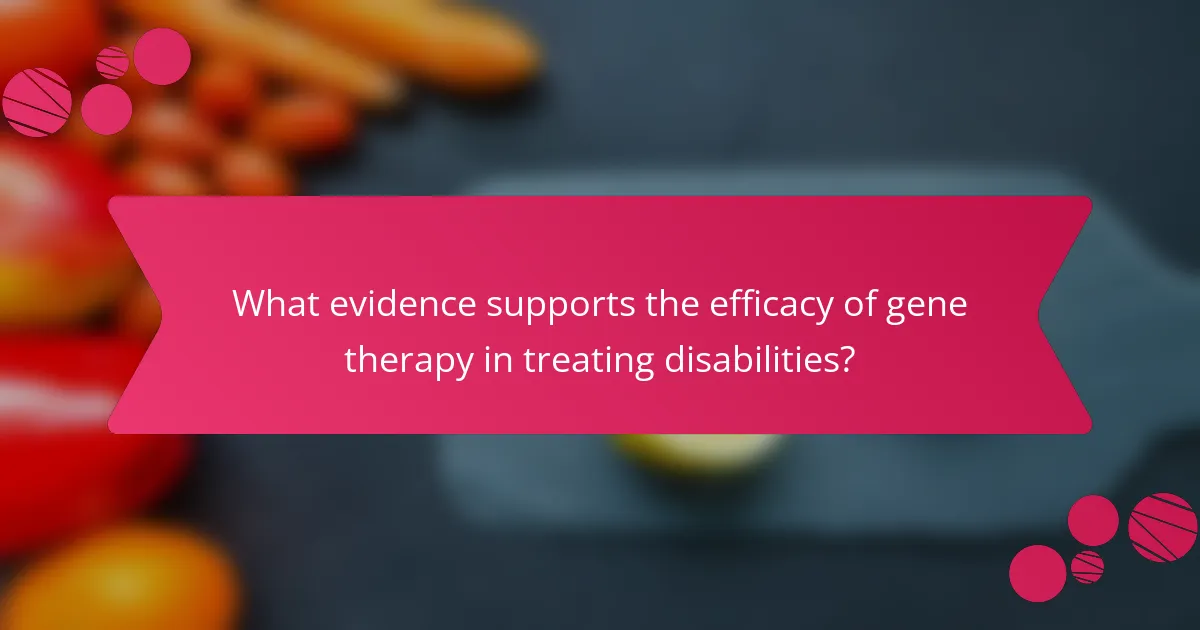
What evidence supports the efficacy of gene therapy in treating disabilities?
Gene therapy has shown significant efficacy in treating disabilities through targeted interventions. Clinical trials demonstrate improvements in conditions like spinal muscular atrophy and certain genetic disorders, with success rates reaching over 80% in some cases. Mechanisms include gene replacement, gene editing, and modulation of gene expression, effectively addressing the underlying causes of disabilities. Future directions focus on expanding applications and enhancing delivery methods, promising even greater impact on patient outcomes.
How have clinical trials demonstrated success in specific conditions?
Clinical trials have shown that gene therapy can significantly improve conditions such as spinal muscular atrophy and certain inherited retinal diseases. These therapies work by correcting or replacing faulty genes, leading to enhanced motor function and vision restoration. For example, the gene therapy Zolgensma has demonstrated a 15-month survival benefit in infants with spinal muscular atrophy. As a result, ongoing trials continue to explore gene therapy’s efficacy across various disabilities, indicating a promising future for innovative treatments.
What metrics are used to measure treatment outcomes in gene therapy?
Gene therapy treatment outcomes are measured using various metrics, including clinical efficacy, safety profiles, and quality of life assessments. Key metrics include genetic correction rates, expression levels of therapeutic genes, and patient-reported outcomes. Monitoring adverse events and long-term durability of effects are also crucial for evaluating success. These metrics help determine the overall impact of gene therapy on disability support and patient health.
Which patient populations have shown the most significant benefits?
Patient populations with significant benefits from gene therapy innovations include those with genetic disorders, neuromuscular diseases, and certain forms of blindness. These groups have shown improvements in symptoms and overall quality of life. For example, patients with spinal muscular atrophy have experienced increased motor function and independence. Additionally, children with inherited retinal diseases have gained vision restoration through targeted gene therapies. The efficacy of these interventions demonstrates the potential of gene therapy to transform the treatment landscape for various disabilities.
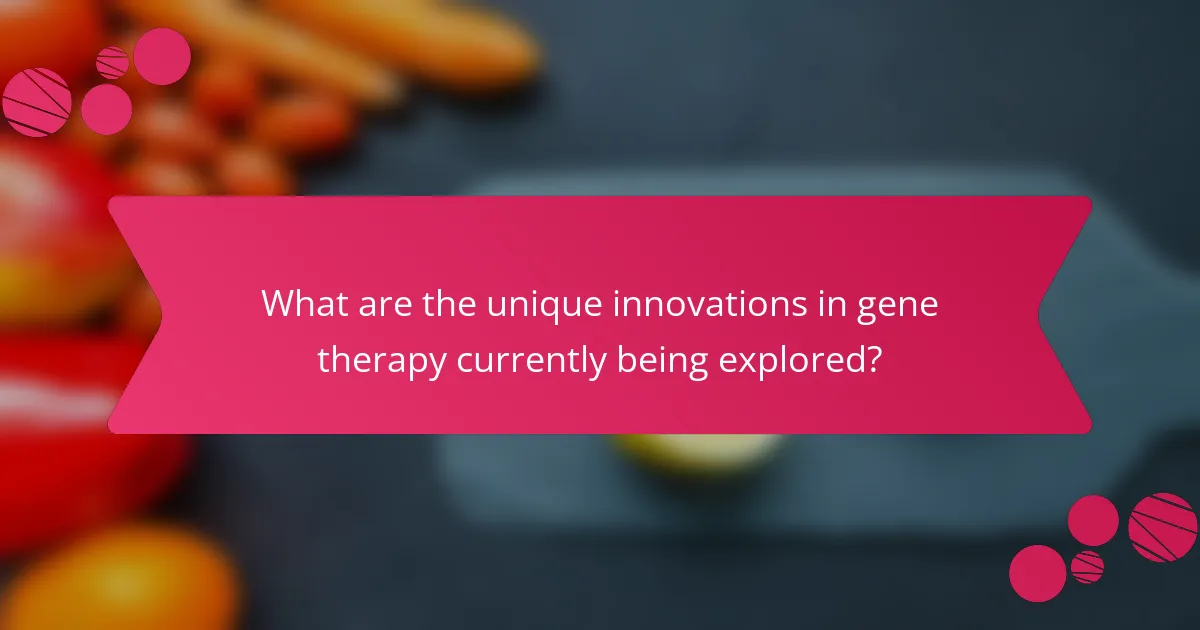
What are the unique innovations in gene therapy currently being explored?
Innovative gene therapy approaches are transforming disability support by targeting specific genetic disorders. Current explorations include CRISPR-Cas9 advancements, which enable precise gene editing, and novel delivery systems like adeno-associated viruses (AAV) that enhance treatment efficacy. Additionally, base editing offers a less invasive method to correct genetic mutations without double-strand breaks. Researchers are also investigating the use of RNA therapies to modulate gene expression, providing new avenues for conditions previously deemed untreatable. These innovations promise to significantly improve patient outcomes and expand the range of treatable disabilities.
How are personalized gene therapies tailored to individual genetic profiles?
Personalized gene therapies are tailored to individual genetic profiles through advanced genomic analysis and targeted delivery methods. These therapies utilize patient-specific genetic information to design treatments that address unique mutations and biological pathways. By analyzing the genetic makeup, clinicians can select appropriate vectors and therapeutic agents that optimize efficacy and minimize adverse effects. This customization enhances the potential for successful outcomes in treating disabilities linked to genetic disorders.
What advancements are being made in non-viral delivery systems?
Advancements in non-viral delivery systems focus on enhancing gene therapy’s effectiveness for disability support. Techniques like lipid nanoparticles and polymer-based carriers improve cellular uptake and reduce immune responses. These innovations enable safer, targeted gene delivery, increasing therapeutic efficacy and patient outcomes.
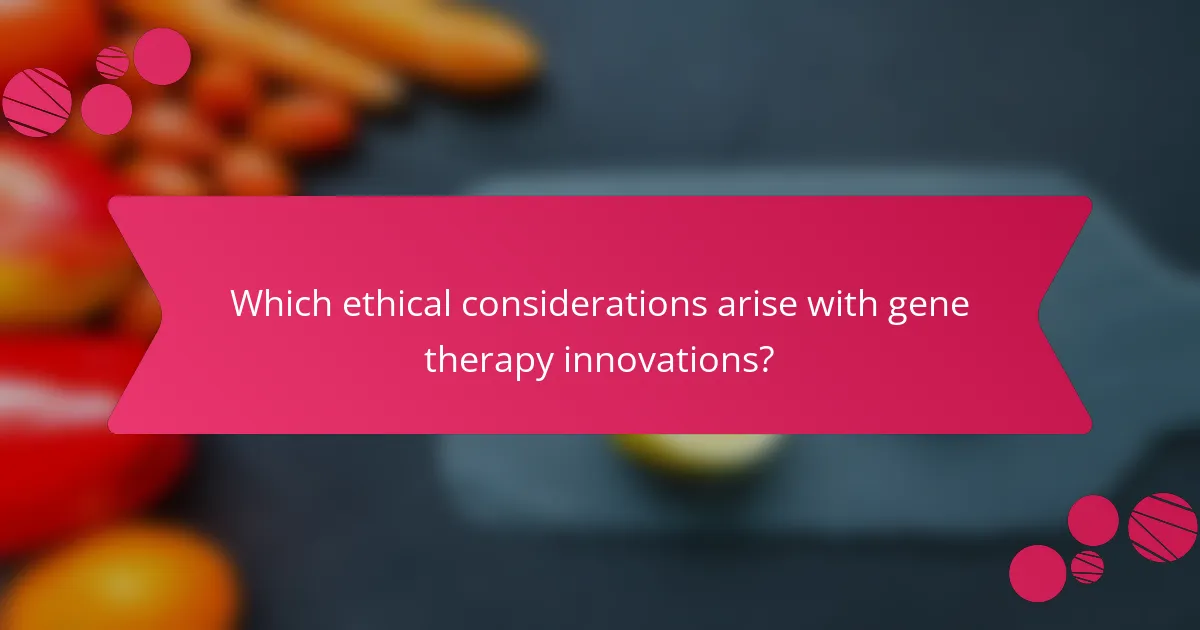
Which ethical considerations arise with gene therapy innovations?
Ethical considerations in gene therapy innovations include potential discrimination, informed consent, and the risk of unintended consequences. These issues arise from the manipulation of genetic material, which can lead to societal implications. The potential for unequal access to therapies further complicates ethical discussions. Additionally, long-term effects on individuals and future generations remain uncertain, raising concerns about the morality of altering human genetics.
What are the implications of genetic modifications on future generations?
Genetic modifications can significantly impact future generations by altering hereditary traits. These modifications can improve health outcomes, reduce disability rates, and enhance quality of life. However, ethical concerns and potential unintended consequences remain critical considerations. Innovations in gene therapy, particularly for disability support, show promise in addressing genetic disorders. The efficacy of these therapies varies, and ongoing research aims to refine mechanisms and assess long-term effects. Future directions may include personalized approaches and broader applications in preventive medicine.
How do regulatory frameworks impact the development of gene therapies?
Regulatory frameworks significantly influence the development of gene therapies by establishing safety and efficacy standards. These regulations can accelerate or delay clinical trials, impacting innovation timelines. For example, streamlined approval processes can foster rapid advancements in gene therapy applications for disabilities. Conversely, stringent regulations may ensure patient safety but could hinder timely access to new treatments. Overall, the balance between regulation and innovation is crucial for the evolution of effective gene therapies.
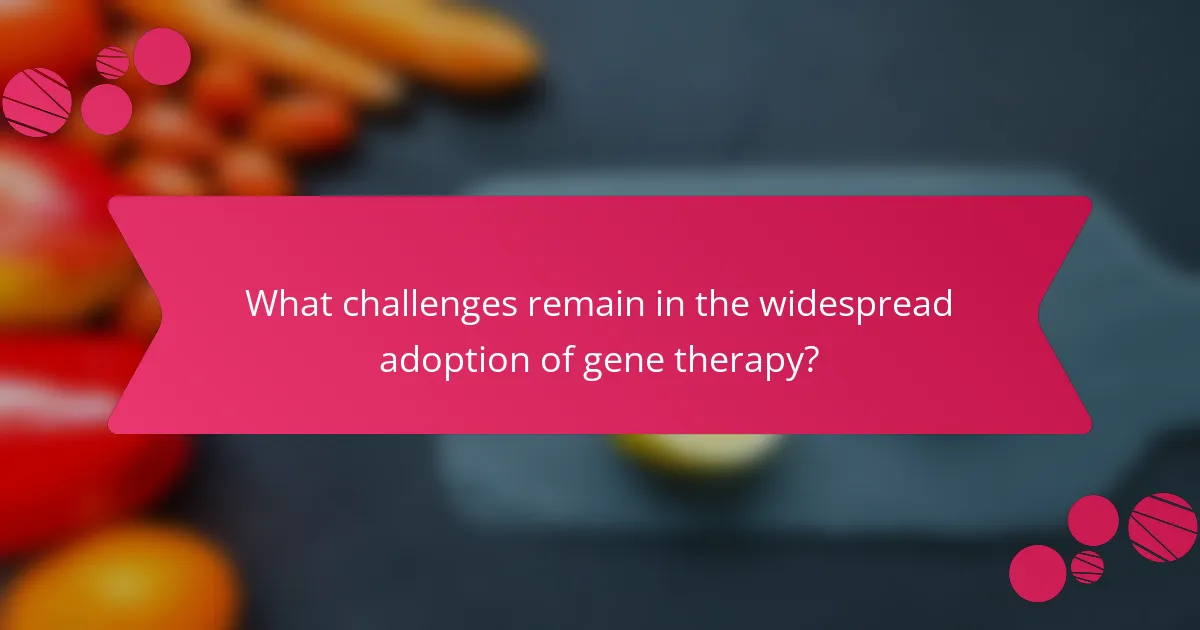
What challenges remain in the widespread adoption of gene therapy?
The widespread adoption of gene therapy faces several challenges. High costs limit accessibility for patients and healthcare systems. Regulatory hurdles delay approval processes, impacting timely implementation. Additionally, public perception and ethical concerns about genetic modifications hinder acceptance. Limited infrastructure for administering therapies also poses a significant barrier.
What are the common barriers to access for patients needing gene therapy?
Common barriers to access for patients needing gene therapy include high costs, limited availability of treatments, regulatory hurdles, and lack of awareness among healthcare providers. These challenges can hinder patient access to potentially life-saving innovations. The high cost of gene therapies often results in insurance limitations, while regulatory processes can delay treatment approvals. Additionally, healthcare providers may not be fully informed about available gene therapies, impacting patient referrals.
How does the cost of gene therapy affect treatment availability?
The high cost of gene therapy significantly limits treatment availability for many patients. Financial barriers prevent equitable access, particularly in low-income populations. For instance, some gene therapies can exceed $1 million per patient, placing them out of reach for average healthcare systems. As a result, insurance coverage and reimbursement policies play critical roles in determining who can receive these innovative treatments. Expanding funding and reducing costs are essential for improving access to gene therapy innovations for disability support.
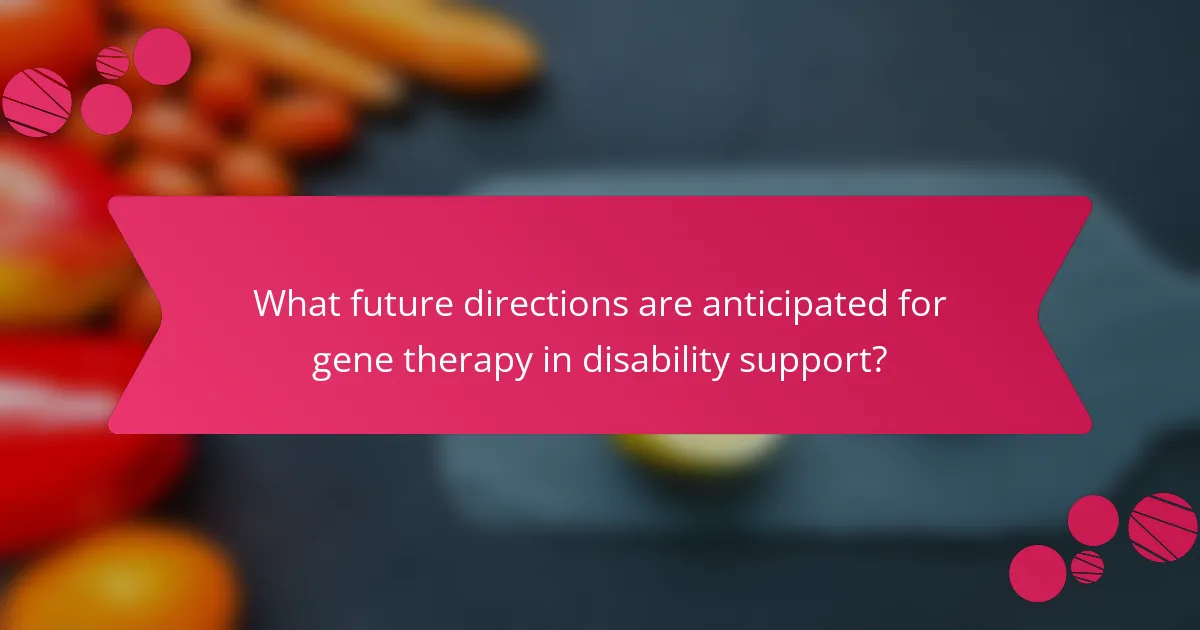
What future directions are anticipated for gene therapy in disability support?
Gene therapy is anticipated to significantly enhance disability support through innovative mechanisms and improved efficacy. Future directions include personalized therapies targeting specific genetic mutations, advancements in delivery methods, and the integration of gene editing technologies like CRISPR. These innovations aim to improve patient outcomes and expand treatment options for various disabilities. Additionally, ongoing research focuses on ethical considerations and accessibility to ensure equitable access to these therapies.
Which emerging technologies could revolutionize gene therapy?
Emerging technologies such as CRISPR, gene editing, and synthetic biology could revolutionize gene therapy. These innovations enhance precision in targeting genetic mutations, improving efficacy in treating disabilities. CRISPR technology, for instance, offers a unique capability to edit genes with high accuracy, potentially correcting genetic disorders at their source. Additionally, advancements in delivery mechanisms, like viral vectors and nanoparticles, may increase the effectiveness of therapies. As research progresses, these technologies promise to transform the landscape of gene therapy for disability support.
How might global collaboration enhance research and development in this field?
Global collaboration can significantly enhance research and development in gene therapy for disability support. By pooling resources and expertise, diverse teams can accelerate innovation and improve efficacy. Collaborative efforts can lead to standardized protocols, shared data, and increased funding opportunities. This synergy fosters a more comprehensive understanding of mechanisms involved in gene therapy, ultimately benefiting patients. Furthermore, global partnerships can facilitate access to cutting-edge technologies and methodologies, driving future directions in this vital field.
What best practices should be followed when considering gene therapy options?
When considering gene therapy options, prioritize informed consent and thorough evaluation of potential risks. Assess the therapy’s mechanism, efficacy, and long-term impacts. Collaborate with healthcare professionals to ensure a tailored approach. Evaluate the availability of clinical trials and the therapy’s regulatory status.
